Grace Elliot's Blog: 'Familiar Felines.' , page 24
April 18, 2012
DEATH CLUB - Poison In Victorian Britain.
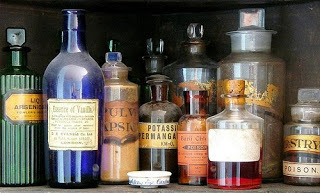
In the early 19th century, the rise of the insurance industry gave murderers a new motivation - a quick profit! At the time it was said of life insurance that although it gave peace of mind, it also provided a path to easy wealth; "by insuring a life and destroying it."For those Victorian's with a mind to 'get rich quick', poison was the perfect tool since many of the victim's symptoms could be passed off a natural disease. Added to that arsenic, strychnine and other toxins easily available, for use as rat bait and the like, and could be bought from the local chemist. The Victorians became paranoid about poison because of a deadly combination of ease of purchase, poor regulation and newspapers reporting on murder trials.
 Arsenic was widely available as rat bait.
Arsenic was widely available as rat bait."To take heed against poison [was now] one of the waking thoughts common to all."Journalist writing in 1850.
Whilst the upper classes took out life insurance, the lower classes joined 'Death Clubs' to avoid the disgrace of a pauper's funeral. Run by Friendly Societies (where tradesmen paid in a weekly amount, in return for financial support if they couldn't work), the idea behind a Death Club was to contribute to a fund that paid out on death, to cover funeral costs.
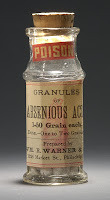
The average cost of a funeral was one to two pounds, and some Manchesterclubs paid out four or even five pounds. Because of the tidy profit to be made by disposing of an unwanted spouse, parent or child, the membership lists soon became known as "The catalogue of the doomed," and amongst the women who inhabited the Manchester tenements there was a saying:
"Aye, that child will not live, it is in the burial club."
Some poor children were enrolled in multiple clubs, so that when each of which paid out on death, the parents reaped twenty pounds or more. A clergyman's wife visiting a bereaved mother to comfort her for the loss of a daughter, was shocked to overhear a neighbour saying:
"A fine thing [for the mother] as the child's in two clubs."
Later in the Victorian era Death Clubs were widely regarded as: 'the prolific mother of arsenical murders" and in response to the problem, in 1850 Parliament enacted a statue prohibiting the insuring of children under 10 for more than three pounds.
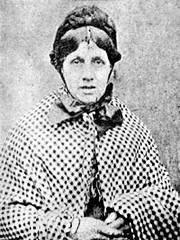 Mary Ann Cotton - or "The Black Widow Poisoner."
Mary Ann Cotton - or "The Black Widow Poisoner."An example of such fearful ruthlessness was Mary Ann Cotton, a candidate for the title of being the most prolific serial killer prior to Doctor Harold Shipman in the 1990's. Cotton, a woman of 'comely' appearance and a former Sunday school teacher used arsenic to murder her mother, three husbands, fifteen children and step-children, and a lodger. In each case the cause of death was 'gastric complaints' and Mary benefited from insurance payments. It took twelve years for people to become suspicious, for Mary to be put on trial and sentenced to death.
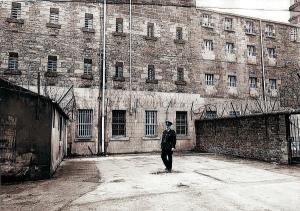 The yard at Durham Prison where Mary was executed.
The yard at Durham Prison where Mary was executed.But finally, what really unsettled the Victorian's was that the killer, Mary, was female. Poisoning was a cowardly, secretive, skulking act and that a female murderer was convicted only confirmed a growing male suspicion that women were sinister, deceitful beings in an almost hysterical way.
"It is the softer sex who are everywhere addicted to this propensity.[to poison]"
 The ultimate rat killer!
The ultimate rat killer!Next week: Sweet Temptation - the hidden danger of poisoned sweets.
Published on April 18, 2012 05:29
April 11, 2012
ACCIDENTAL MURDER - Poison in Victorian Britain.
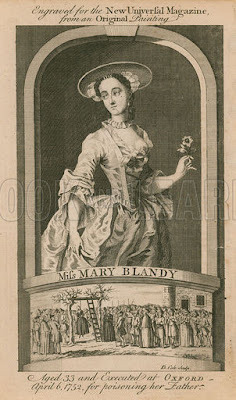
Part ONE - A Story of Agony.
"Murder…by poison is the most dreadful, as it takes a man unguarded and gives him no opportunity to defend himself" Counsel for the Crown in the Mary Blandy case. 1752
Welcome to a new series of blog posts about poison in Victorian Britain. Murder by poisoning was an obsession with the Victorians - whilst ignoring the poison surrounding them in their homes; from the rat bait that could be mistaken for flour, to the pigment in wallpaper. Over the next few weeks we will look at the poisoner's art, accidental poisonings, dangers in the home and at work, and how physicians poisoned their patients.

The Case of Mary Blandy.
The root of the Victorian horror of poisoning can be found a hundred years earlier, in the case of Mary Blandy. In childhood Mary was disfigured by smallpox, but with a dowry of 10,000 pounds she had hopes of marriage. However, none of her suitors met the stringent standards set by her father, Francis Blandy. Then along came Captain William Cranstoun, who although a short, pock-marked, clumsy man, had the advantage of being a scion of Scottish aristocracy and his suit was welcomed by Mr Blandy. Mary and William became engaged, but then disaster! Francis Blandy found out his prospective son-in-law was already married. Captain Cranstoun left in disgrace, but unknown to Mr Blandy, kept up a correspondence with the infatuated Mary.
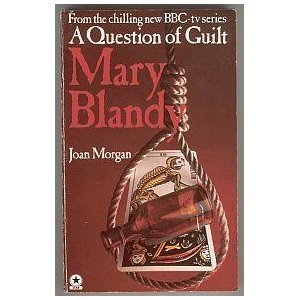
Cranstoun wrote to the besotted woman, enclosing a 'powder of forgiveness' to put into her father's tea. Apparently, with this potion, her father's objection to them being together would vanish and all would be well. She did as instructed on numerous occasions, even doubling the dose when it seemed to have little effect and then Mr Blandy grew ill, suffering terribly:
"A fireball in his stomach" and "one of the effects being that the teeth dropping out of his head, whole from their sockets."
Servants noticed a strange white residue at the bottom of his tea cup and called a physician, who concluded the powder was arsenic. When the father was informed his daughter was likely poisoning him, he replied:
"Poor love-sick girl! What will not a woman do for the man she loves!"
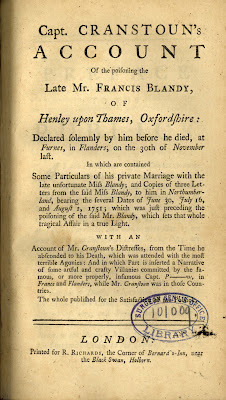 Francis died 14 August 1751, but he had exaggerated his wealth and his daughter's dowry was a fraction of the 10,000 pounds he advertised. So who knows if Cranstoun would have resorted to a capital offence so such a lesser amount?
Francis died 14 August 1751, but he had exaggerated his wealth and his daughter's dowry was a fraction of the 10,000 pounds he advertised. So who knows if Cranstoun would have resorted to a capital offence so such a lesser amount? Mary was arrested and imprisoned at Oxford, and her story dominated the newspapers, and a play written about her story. "The Fair Parricide, A Tragedy in Three Acts."
We will never know whether Mary had been duped or a willing accessory to murdering her father - but she was hung on 6 April 1752.
On news of Mary's arrest Cranstoun fled to France and evaded punishment. However, nine months later he became ill, the symptoms not unlike those of poisoning:
"Such torments…such great agonies as to make him wish for death some days before he died."
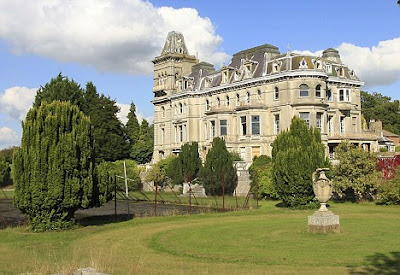 Mary's ghost is said to walk the grounds of Park Place, Henley-On-Thams.
Mary's ghost is said to walk the grounds of Park Place, Henley-On-Thams.The poison used by Mary Blandy was arsenic. The poison can be absorbed through the skin, gut or mucous membranes such as the vagina or rectum. In the 18th century one servant, who failed to kill his mistress with arsenic laced soup, succeeded by adding it to her enema liquid!
Indeed, a 16th Century German farmer is attributed with murdering three wives by inserting an arsenic coated finger into their vaginas after coition.
So if arsenic had been around for a long time, why did the Victorian's fear of it reach near hysterical proportions? Find out next week!
 Easter Lilies are poisonous to cats and cause kidney failure.
Easter Lilies are poisonous to cats and cause kidney failure.Part TWO -The Female Poisoner.
Published on April 11, 2012 04:12
April 4, 2012
The Great Seducers- Forewarned is Forearmed!

In this, the last post on 'The Great Seducers' I look at the other side of the coin - their victims! Just as the seducers can be categorised, so can the people they prey on. So here goes - if you're not a master seducer, then caste your eye over the following list and see where you are most vulnerable to their attentions.
The Reformed Pleasure Seeker.In their younger years they were happy go lucky but the day came when they decided to settle down to marriage and a family. But from time to time this leaves a lingering sense of resentment or loss, when they think of recapturing those lost pleasures an elicit relationship…

The Disillusioned Dreamer.As children they were loners, immersing themselves in books and films. They dreamed of romantic heroes and as they grew older, became disillusioned by the pettiness of everyday life. They learn to compromise but deep down, still hunger for something grander and more romantic.
The Pampered Princess.The classic spoilt child whose every whim was met by their adoring parents. As adults when their parents are no longer available, they tend to get bored and restless. They seek pleasure and move from job to job, looking for fulfilment. What they really want is a person who will spoil them and give them what they crave.
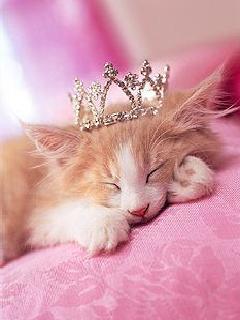
The New-Age Prude. The prude is concerned about appearances, about political correctness, fairness and tastefulness. Deep down they are excited by transgressive pleasures and as an over correction, run in the opposite direction. They are judgemental and addicted to routine …and attracted to those they feel need reforming, making them vulnerable to those who confide in them and seem open to redemption.
The Neglected Star. At one point in their life the crushed star was the centre of attention; perhaps an athlete or a high achiever, but that time passed. To cope they tamp down their desires, but attention makes them glow, and someone who makes them the feel special is powerful indeed.

The Intellectual. The intellectual debates and analyses the simplest thing, and are actually trapped in a mental prison of their own making. Unconsciously they long to have their reason overwhelmed by someone who is purely physical.
The Ageing Beauty. She constantly worries about her fading looks, and so pretends she doesn't value beauty. Her weakness is some one who worships her looks, but crucially, also celebrates her intellect and humour.

The Roué They often appear cynical and jaded, having led lives of pleasure fuelled by money and position. Their weakness is the young and seemingly innocent, qualities they begin to covet in themselves.
The Drifter.They have an inner emptiness, searching the world for a cause to satisfy them. They are vulnerable to someone who seems worthy of follower, who represents a noble cause or high ideals.
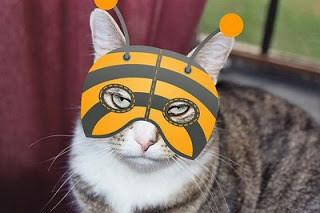
This is by no means an exhaustive list. From your observations of human nature…what others can you suggest?
Published on April 04, 2012 03:52
March 28, 2012
The Great Seducers - The STAR.

"She had the one essential star quality: she could be magnificent doing nothing."Lili Darvas (actress) on Marlene Dietrich.
The star represents the real and the unreal. The cinema star is a creation of a real actor in an imaginary role, that appeals to the need of the viewer for escape from the monotony of life. What the true star knows is how to carry this experience over into real world beyond the cinema screen, and appeal to the fantasies of those watching.
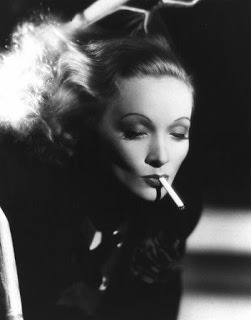 Marlene Dietrich"The collective seduction produced by modern times is that of film stars or cinema idols. They were our only myth in an age incapable of generating great figures of seduction comparable to those of mythology or art." Jean Baudrillard.
Marlene Dietrich"The collective seduction produced by modern times is that of film stars or cinema idols. They were our only myth in an age incapable of generating great figures of seduction comparable to those of mythology or art." Jean Baudrillard.Stars stand out from the crowd, they draw attention just by being present. They are ethereal, unobtainable and represent whatever our imagination superimposes on them. Stars have that power by projecting a glittering, desirable but elusive quality. This is perfectly illustrated by the story of the young actress, Marlene Dietrich at a casting session. Whilst the other girls tried to catch the casting director's eye, she merely stood, smoking a cigarette with slow, languid gestures. She had a sinuous way of moving, even a coldness in her eye, that marked her apart and by the time she came to the front of the line, she had already got the part.
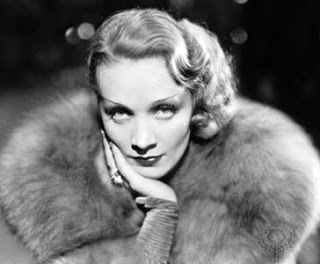 "The cool, bright face which didn't ask for anything, which simply existed, waiting….One could dream into it anything."
"The cool, bright face which didn't ask for anything, which simply existed, waiting….One could dream into it anything." Erich Remarque on Marlene Dietrich.
What Dietrich had learnt was to be aloof, and by being still, she drew attention. She also challenged those looking at her, staring directly at people, in an almost masculine way. She created a provocative aura that meant eyes followed her every move and when she was on stage everyone watched her. But this was no accident, she studied her facial expressions from every angle, taking photographs and angled mirrors, to visualise how she appeared to others, nothing was left to chance. In other words, even when she wasn't on stage, she was acting. She saw herself as an object, much like a statue of a greek goddess, and learnt to radiate and dazzle with her movements and facial expression.
 One way of avoiding the paparazzi!
One way of avoiding the paparazzi!"The savage worships idols of wood and stone; the civilized man, idols of flesh and blood."George Bernard Shaw
Published on March 28, 2012 03:34
March 21, 2012
The Great Seducers - The CHARISMATIC.
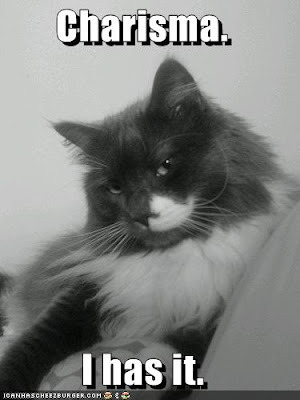 The charismatic seducer is an exciting person. Their self-confidence and air of purpose make them attractive to people who lack those properties and desire them. Charismatics work on the large scale, capable of seducing not just individual people but crowds.
The charismatic seducer is an exciting person. Their self-confidence and air of purpose make them attractive to people who lack those properties and desire them. Charismatics work on the large scale, capable of seducing not just individual people but crowds.
"Charismatic authority refers to a rule over men…to which the governed submit themselves because of their belief in the extraordinary quality of the specific person."Max Weber. Essays in Sociology.
Examples could be taken of Robespierre or Lenin, men of great vision with extraordinary plans who were able to inspire the public. As for the charismatic seducer, their appeal comes from an almost mystical way of giving people something to believe in. They do this in the following way:
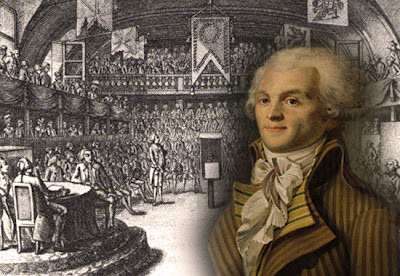 Robespierre.-Purpose -
Robespierre.-Purpose -
They have purpose and act decisiveness, which in uncertain times is an attractive quality. "That man could make me go through the eye of a needle to throw myself into the fire."General Vandamme on Napoleon.
-Mystery -
This is the mystery of being a contradiction; the charismatic can be both kind and cruel (Peter the Great), detached and excitable (Charles de Gaulle) or distant and yet intimate (Sigmund Freud). It makes their character harder to understand and therefore more intriguing. "The masses have never thirsted after truth. They demand illusion and cannot do without them."Sigmund Freud.
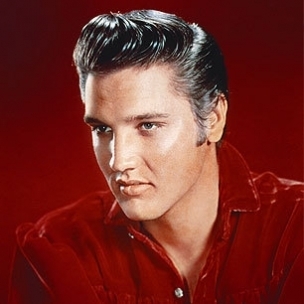 Elvis Presley. Eloquence - Charismatics are good with words, they can weave words and inspire, uplift or anger.
Elvis Presley. Eloquence - Charismatics are good with words, they can weave words and inspire, uplift or anger.
-Showmanship - They are naturally larger than life characters, who know how to command attention without trying too hard.
- Fervent -Their beliefs make them fervent, adding animations to their speech and gestures; they would even believe their own lies if necessary.
-Magnetism -They are also good at non-verbal communication, such as the piercing gaze. They often appear poised and calm, and yet their eyes are magnetic, and never show fear or nerves.
 Marilyn MonroeExamples of charismatics are numerous and diverse, ranging from politicians to film stars, from kings to monks. People such as Napoleon, Lenin, Robespierre, Rasputin, Eva Peron, Marilyn Monroe and Elvis Presley.
Marilyn MonroeExamples of charismatics are numerous and diverse, ranging from politicians to film stars, from kings to monks. People such as Napoleon, Lenin, Robespierre, Rasputin, Eva Peron, Marilyn Monroe and Elvis Presley.
"I do not pretend to be a divine man, but I do believe in divine guidance, divine power and divine prophecy."Napoleon.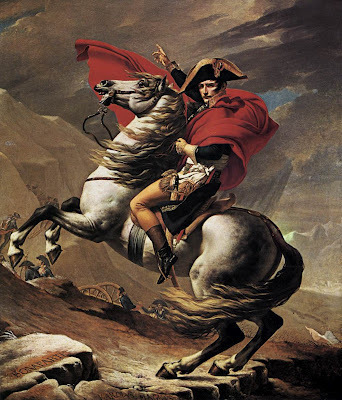 Napoleon.
Napoleon.
Next week - The Great Seducers - The STAR.
 The charismatic seducer is an exciting person. Their self-confidence and air of purpose make them attractive to people who lack those properties and desire them. Charismatics work on the large scale, capable of seducing not just individual people but crowds.
The charismatic seducer is an exciting person. Their self-confidence and air of purpose make them attractive to people who lack those properties and desire them. Charismatics work on the large scale, capable of seducing not just individual people but crowds. "Charismatic authority refers to a rule over men…to which the governed submit themselves because of their belief in the extraordinary quality of the specific person."Max Weber. Essays in Sociology.
Examples could be taken of Robespierre or Lenin, men of great vision with extraordinary plans who were able to inspire the public. As for the charismatic seducer, their appeal comes from an almost mystical way of giving people something to believe in. They do this in the following way:
 Robespierre.-Purpose -
Robespierre.-Purpose - They have purpose and act decisiveness, which in uncertain times is an attractive quality. "That man could make me go through the eye of a needle to throw myself into the fire."General Vandamme on Napoleon.
-Mystery -
This is the mystery of being a contradiction; the charismatic can be both kind and cruel (Peter the Great), detached and excitable (Charles de Gaulle) or distant and yet intimate (Sigmund Freud). It makes their character harder to understand and therefore more intriguing. "The masses have never thirsted after truth. They demand illusion and cannot do without them."Sigmund Freud.
 Elvis Presley. Eloquence - Charismatics are good with words, they can weave words and inspire, uplift or anger.
Elvis Presley. Eloquence - Charismatics are good with words, they can weave words and inspire, uplift or anger. -Showmanship - They are naturally larger than life characters, who know how to command attention without trying too hard.
- Fervent -Their beliefs make them fervent, adding animations to their speech and gestures; they would even believe their own lies if necessary.
-Magnetism -They are also good at non-verbal communication, such as the piercing gaze. They often appear poised and calm, and yet their eyes are magnetic, and never show fear or nerves.
 Marilyn MonroeExamples of charismatics are numerous and diverse, ranging from politicians to film stars, from kings to monks. People such as Napoleon, Lenin, Robespierre, Rasputin, Eva Peron, Marilyn Monroe and Elvis Presley.
Marilyn MonroeExamples of charismatics are numerous and diverse, ranging from politicians to film stars, from kings to monks. People such as Napoleon, Lenin, Robespierre, Rasputin, Eva Peron, Marilyn Monroe and Elvis Presley."I do not pretend to be a divine man, but I do believe in divine guidance, divine power and divine prophecy."Napoleon.
 Napoleon.
Napoleon.Next week - The Great Seducers - The STAR.
Published on March 21, 2012 05:40
March 14, 2012
The Great Seducers - the CHARMER.
"Wax, a substance naturally hard and brittle, can be made soft by the application of a little warmth."Arthur Schopenhauer.
 with thanks to Cheezeburger.comI don't know how many of you watch Coronation Street, but the Nigel Havers character is a perfect example of a charmer.
with thanks to Cheezeburger.comI don't know how many of you watch Coronation Street, but the Nigel Havers character is a perfect example of a charmer.
Charmers cast their spell by subtle means, they adapt to your moods, they flatter and reassure, they make you feel good about yourself and don't like talking about themselves until you are completely taken in.
"Birds are taken in with pipes that imitate their voices,And men with sayings that are most agreeable to their own opinions."Samuel Butler.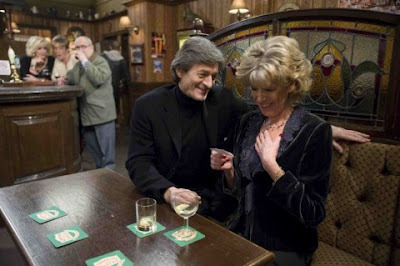 Nigel Havers as Lewis, charming Audrey.(Coronation Street)The word 'charm' originates from a Latin word, 'carmen', which means a song or incantation. The aim of the charmer is to disarm by lowering his victim's sense of reason, by subtly dismantling her fears.
Nigel Havers as Lewis, charming Audrey.(Coronation Street)The word 'charm' originates from a Latin word, 'carmen', which means a song or incantation. The aim of the charmer is to disarm by lowering his victim's sense of reason, by subtly dismantling her fears.
"Talk to a man about himself and he will listen for hours."Benjamin Disraeli.
Charmers have a number of golden rules:
1 - Make your target the centre of attention.2 - Be a source of pleasure. 3 - Bring harmony to those around you. 4 - Lull your victim into comfort and ease.5 - Be calm in the face of opposition.6 - Be helpful and useful.
"You know what charm is: a way of getting the answer yes without having asked any clear question."Albert Camus
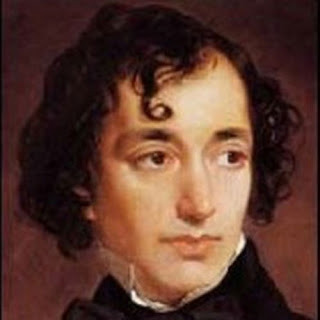 The young, Benjamin Disraeli.Our example from history of a charmer, is a little unusual - the British Prime Minister to Queen Victoria, (who in 1860 was still mourning the death of her beloved Albert) - Benjamin Disraeli. In his younger life Disraeli dressed as a dandy and wrote novels, - with a reputation for being flamboyant he was the antithesis of what the dour, formal and stubborn queen looked for in her Prime Minister. But Disraeli used this to his advantage.
The young, Benjamin Disraeli.Our example from history of a charmer, is a little unusual - the British Prime Minister to Queen Victoria, (who in 1860 was still mourning the death of her beloved Albert) - Benjamin Disraeli. In his younger life Disraeli dressed as a dandy and wrote novels, - with a reputation for being flamboyant he was the antithesis of what the dour, formal and stubborn queen looked for in her Prime Minister. But Disraeli used this to his advantage.
He approached the queen in the role of a gallant prince, falling to one knee, taking her hand and saying:"I plight my troth to the kindest of mistresses."
He went on to praise her so heartily that she blushed. He sent her volumes of his work and when she reciprocated with a book she had written, "Journal of Our Life in the Highlands", he referred to her with the phrase, "We authors."
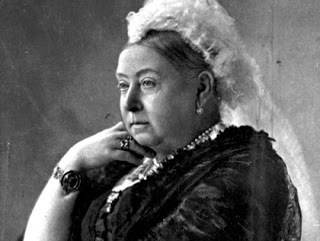 Queen Victoria - not immediately obvious as someone who could be charmed! At important meeting he would suddenly break away, turn to Victoria and ask for her advice. He sent her flowers, primroses, - a flower so ordinary it might have been considered insulting except he sent a note: "Of all the flowers, the one that retains its beauty the longest is the sweet primrose." And soon primroses became Victoria's favourite flower.
Queen Victoria - not immediately obvious as someone who could be charmed! At important meeting he would suddenly break away, turn to Victoria and ask for her advice. He sent her flowers, primroses, - a flower so ordinary it might have been considered insulting except he sent a note: "Of all the flowers, the one that retains its beauty the longest is the sweet primrose." And soon primroses became Victoria's favourite flower.
When in 1876 Disraeli proposed a bill declaring Queen Victoria as "Queen-Empress" she was beside herself with gratitude and elevated the former dandy and novelist to the peerage.
What Disraeli had learnt was never to judge by appearances: he saw a frosty, dour woman but appealed to the part of her that wanted male attention and made her feel the most attractive and intelligent woman alive.
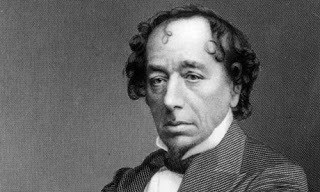 Disraeli - in later life. "When I left the dining room after sitting next to Mr. Gladstone, I thought he was the cleverest man in England. After sitting next to Mr. Disraeli, I thought I was the cleverest woman in England."An English Princess.
Disraeli - in later life. "When I left the dining room after sitting next to Mr. Gladstone, I thought he was the cleverest man in England. After sitting next to Mr. Disraeli, I thought I was the cleverest woman in England."An English Princess.
NEXT WEEK: The CHARISMATIC.
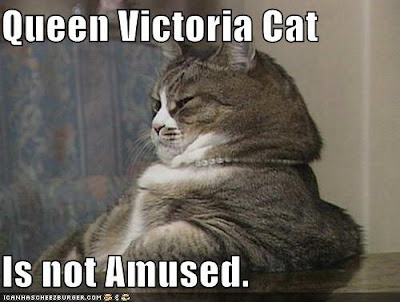 With thanks to cheezeburger.com
With thanks to cheezeburger.com

 with thanks to Cheezeburger.comI don't know how many of you watch Coronation Street, but the Nigel Havers character is a perfect example of a charmer.
with thanks to Cheezeburger.comI don't know how many of you watch Coronation Street, but the Nigel Havers character is a perfect example of a charmer. Charmers cast their spell by subtle means, they adapt to your moods, they flatter and reassure, they make you feel good about yourself and don't like talking about themselves until you are completely taken in.
"Birds are taken in with pipes that imitate their voices,And men with sayings that are most agreeable to their own opinions."Samuel Butler.
 Nigel Havers as Lewis, charming Audrey.(Coronation Street)The word 'charm' originates from a Latin word, 'carmen', which means a song or incantation. The aim of the charmer is to disarm by lowering his victim's sense of reason, by subtly dismantling her fears.
Nigel Havers as Lewis, charming Audrey.(Coronation Street)The word 'charm' originates from a Latin word, 'carmen', which means a song or incantation. The aim of the charmer is to disarm by lowering his victim's sense of reason, by subtly dismantling her fears. "Talk to a man about himself and he will listen for hours."Benjamin Disraeli.
Charmers have a number of golden rules:
1 - Make your target the centre of attention.2 - Be a source of pleasure. 3 - Bring harmony to those around you. 4 - Lull your victim into comfort and ease.5 - Be calm in the face of opposition.6 - Be helpful and useful.
"You know what charm is: a way of getting the answer yes without having asked any clear question."Albert Camus
 The young, Benjamin Disraeli.Our example from history of a charmer, is a little unusual - the British Prime Minister to Queen Victoria, (who in 1860 was still mourning the death of her beloved Albert) - Benjamin Disraeli. In his younger life Disraeli dressed as a dandy and wrote novels, - with a reputation for being flamboyant he was the antithesis of what the dour, formal and stubborn queen looked for in her Prime Minister. But Disraeli used this to his advantage.
The young, Benjamin Disraeli.Our example from history of a charmer, is a little unusual - the British Prime Minister to Queen Victoria, (who in 1860 was still mourning the death of her beloved Albert) - Benjamin Disraeli. In his younger life Disraeli dressed as a dandy and wrote novels, - with a reputation for being flamboyant he was the antithesis of what the dour, formal and stubborn queen looked for in her Prime Minister. But Disraeli used this to his advantage.He approached the queen in the role of a gallant prince, falling to one knee, taking her hand and saying:"I plight my troth to the kindest of mistresses."
He went on to praise her so heartily that she blushed. He sent her volumes of his work and when she reciprocated with a book she had written, "Journal of Our Life in the Highlands", he referred to her with the phrase, "We authors."
 Queen Victoria - not immediately obvious as someone who could be charmed! At important meeting he would suddenly break away, turn to Victoria and ask for her advice. He sent her flowers, primroses, - a flower so ordinary it might have been considered insulting except he sent a note: "Of all the flowers, the one that retains its beauty the longest is the sweet primrose." And soon primroses became Victoria's favourite flower.
Queen Victoria - not immediately obvious as someone who could be charmed! At important meeting he would suddenly break away, turn to Victoria and ask for her advice. He sent her flowers, primroses, - a flower so ordinary it might have been considered insulting except he sent a note: "Of all the flowers, the one that retains its beauty the longest is the sweet primrose." And soon primroses became Victoria's favourite flower. When in 1876 Disraeli proposed a bill declaring Queen Victoria as "Queen-Empress" she was beside herself with gratitude and elevated the former dandy and novelist to the peerage.
What Disraeli had learnt was never to judge by appearances: he saw a frosty, dour woman but appealed to the part of her that wanted male attention and made her feel the most attractive and intelligent woman alive.
 Disraeli - in later life. "When I left the dining room after sitting next to Mr. Gladstone, I thought he was the cleverest man in England. After sitting next to Mr. Disraeli, I thought I was the cleverest woman in England."An English Princess.
Disraeli - in later life. "When I left the dining room after sitting next to Mr. Gladstone, I thought he was the cleverest man in England. After sitting next to Mr. Disraeli, I thought I was the cleverest woman in England."An English Princess. NEXT WEEK: The CHARISMATIC.
 With thanks to cheezeburger.com
With thanks to cheezeburger.com
Published on March 14, 2012 08:09
March 7, 2012
The Great Seducers - The COQUETTE.
 Next on the list of this catalogue of seducers is the coquette. "There are indeed men who are attached more by resistance than by yielding."
Next on the list of this catalogue of seducers is the coquette. "There are indeed men who are attached more by resistance than by yielding."Imbert de Saint-Amand.
It is a reflection of human nature that for some an easy conquest holds lower value than a difficult one. The power of the coquette is in enticing her victim whilst herself turning away, thus making her prey come to her. She is mistress of arousing insecurity by using her inconsistency, and knows that should her quarry become angry, this is a sign he is under her spell.
"She who would long retain her power must use her lover ill."
Ovid.
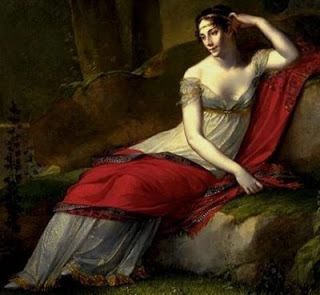 Josephine.Some may say the coquette is a tease, who cares more for herself than others, but it is this selfishness which draws people to her. Men are challenged by the coquette's independence, desiring to be the one to enslave her…whilst it's far more likely he will become the victim. She is not emotionally needy and this self-sufficiency is surprisingly attractive, especially to powerful men who are more used to women throwing themselves in their path than having to work to get attention.
Josephine.Some may say the coquette is a tease, who cares more for herself than others, but it is this selfishness which draws people to her. Men are challenged by the coquette's independence, desiring to be the one to enslave her…whilst it's far more likely he will become the victim. She is not emotionally needy and this self-sufficiency is surprisingly attractive, especially to powerful men who are more used to women throwing themselves in their path than having to work to get attention.Coquettes are never jealous, but arouse jealousy in others, often by showing interest in a third party and creating a triangle of desire. Let us take as our example of Josephine Beauharnais, who eventually married Napoleon Bonaparte.
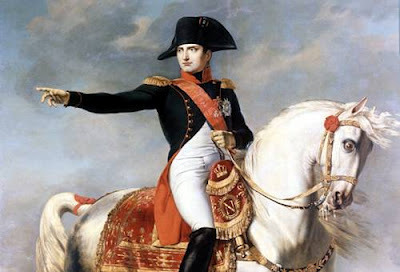 Napoleon Bonaparte.
Napoleon Bonaparte."Josephine had to deal with a conqueror and that love resembles war. She did not surrender, she let herself be conquered. Had she been more tender, more attentive, more loving, perhaps Bonaparte would have loved her less."
Imbert de Saint-Amand.
A vicomtesse, during the French revolution she narrowly escaped execution. Josephine was languorous, exotic and sensuous with a reputation as a loose woman, whilst Napoleon was shy and believed in marriage. She invited Napoleon into her glittering social circle, and although he felt uncomfortable amongst the great writers and wits, she singled him out and thus made him feel special. She wrote him passionate letters, but when he called she seemed cold and reserved…and so the challenge was issued to a man who loved nothing better than a battle.
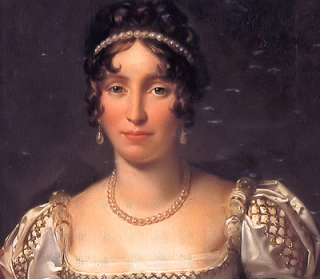 Josephine.But when Josephine eventually married Bonaparte, his troubles were only just beginning. Two days after the wedding Napoleon left to lead a campaign in northern Italy against the Austrians. He wrote to his new wife,
Josephine.But when Josephine eventually married Bonaparte, his troubles were only just beginning. Two days after the wedding Napoleon left to lead a campaign in northern Italy against the Austrians. He wrote to his new wife,"You are the constant object of my thoughts. My imagination exhausts itself in guessing what you are doing."
But she wrote back infrequently and her letters lacked passion, which drove him to distraction. Napoleon threw this frustration into war against the enemy, whilst his letters to his wife became ever more desperate.
"I work to get near you; I kill myself to reach you."
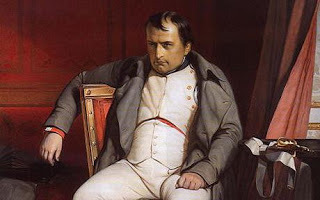 A less flattering portrait of Napoleon.In short, Josephine became a motivating force behind the army's victory. When they eventually did meet, Napoleon spent long hours in a darkened carriage with his wife, whilst his generals fumed as meetings were missed and orders went unissued. Later Napoleon wrote:
A less flattering portrait of Napoleon.In short, Josephine became a motivating force behind the army's victory. When they eventually did meet, Napoleon spent long hours in a darkened carriage with his wife, whilst his generals fumed as meetings were missed and orders went unissued. Later Napoleon wrote:"Never has a woman been in such complete mastery of another's heart."
Despite rumours of Josephine taking lovers, Napoleon eventually made her empress and on his deathbed, reportedly the last word he uttered was:
"Josephine."
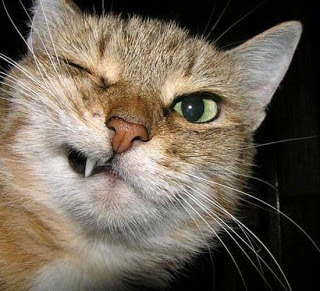
Next week: The CHARMER
Published on March 07, 2012 11:36
February 29, 2012
The Great Seducers - The DANDY.
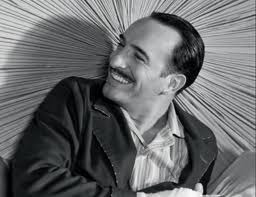 Jean duJardin as George Valentin, in 'The Artist.'This week in this series of posts, we consider the dandy and his methods of seduction. This is a especially apt because "The Artist" has just won several Oscars, including those for best movie and best actor. The film tells the story of silent screen star George Valentin and is loosely based on the life of Rudolph Valentino, who was very much a dandy. So with this timely link, let's take a look at what makes a dandy.
Jean duJardin as George Valentin, in 'The Artist.'This week in this series of posts, we consider the dandy and his methods of seduction. This is a especially apt because "The Artist" has just won several Oscars, including those for best movie and best actor. The film tells the story of silent screen star George Valentin and is loosely based on the life of Rudolph Valentino, who was very much a dandy. So with this timely link, let's take a look at what makes a dandy.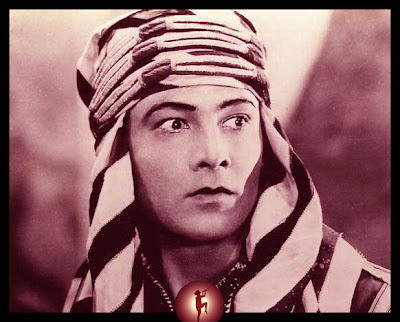 Rudolph Valention - in his role as 'The Sheikh.'Dandies exist to please themselves, love beauty and like to be different. They don't like to conform and yet first glance, aren't threatening, but have the potential to thrill. Dandies are bold enough to 'be themselves', and never try too hard to get attention and yet always seem to attract it. Ultimately, a successful dandy invites imitation, such as Beau Brummell, and his immaculate tailoring.
Rudolph Valention - in his role as 'The Sheikh.'Dandies exist to please themselves, love beauty and like to be different. They don't like to conform and yet first glance, aren't threatening, but have the potential to thrill. Dandies are bold enough to 'be themselves', and never try too hard to get attention and yet always seem to attract it. Ultimately, a successful dandy invites imitation, such as Beau Brummell, and his immaculate tailoring. "The fit of his [Brummell] gloves was achieved by entrusting their cut to two firms- one for the fingers, the other for the thumbs"Harriett Wilson's Memoirs.
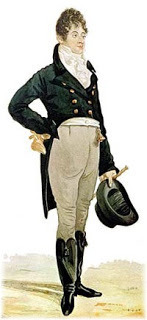 Beau Brummell - he made a career out of being a dandy.Physical appearance is very important to the dandy, with an almost effeminate attention to detail. Their unconventional dress isn't necessarily in shocking, but as with Valentino in the 1920's who used to wear bracelets, has unusual touches.
Beau Brummell - he made a career out of being a dandy.Physical appearance is very important to the dandy, with an almost effeminate attention to detail. Their unconventional dress isn't necessarily in shocking, but as with Valentino in the 1920's who used to wear bracelets, has unusual touches. In his most famous movie, The Sheikh, Valentino reversed gender roles. He wore eye make up and flowing robes, whilst the heroine wore trousers. He appears confusingly feminine but his behaviour is masculine, which cinema audiences of the day found hugely exciting. Valentino understood this and reflected it in his off-screen life, presenting an exotic, almost feminine image, but could sweep women off their feet with his masculinity. His hallmark, on and off screen, was to woo as a woman might: slowly, attentively and savouring each moment, and yet when the time was ripe, close in with thrilling boldness.
What Valentino managed on a huge scale was the mass seduction of women via the cinema screen. When he died at the tragically young age of 31 (from surgical complications) America saw an unprecedented out pouring of emotion. Some 100,000 people filed past his coffin, many of the mourners hysterical and crazed with grief.
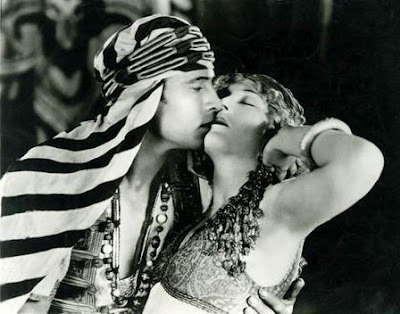 The Sheikh - Valention in his most successful role.Another fundamental characteristic of the dandy is their impudence.
The Sheikh - Valention in his most successful role.Another fundamental characteristic of the dandy is their impudence. "Dandies please women by displeasing themselves"Barbey d'Aurevilly.
Something of this aloofness was reflected by the consummate dandy, Oscar Wilde. Whilst attending the first performance of one of his plays, the audience appealled for Wilde to appear on stage. He made them wait and wait, and when he eventually distained to agree, he explained the delay thus:
"It may be bad manners to appear here smoking, but it is far worse to disturb me when I am smoking." Oscar Wilde.
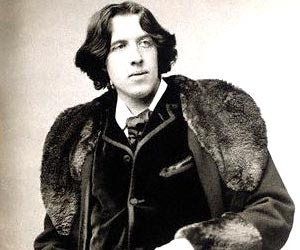 Oscar Wilde.
Oscar Wilde.And finally, dandies live for pleasure, rather than work. They love to surround themselves with beautiful things and eat wonderful food. By making everything an aesthetic choice, when they deign turn their attention on a woman, she doesn't stand a chance!
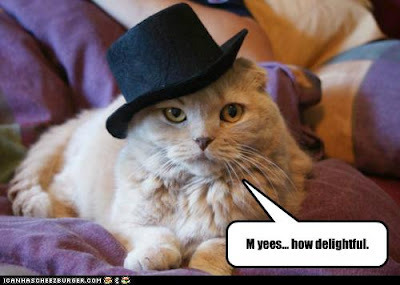 Dandies love to accessorize! (With thanks for Cheezburger.com)
Dandies love to accessorize! (With thanks for Cheezburger.com)
Published on February 29, 2012 10:29
February 22, 2012
The Great Seducers (part 3) - The Ideal Lover

The first two parts of this series looked at the siren (who masters by manipulation) and the rake (adores but unable to commit). Today's post and our third type of seducer, is 'the ideal lover', who in theory should be less threatening to our composure, but in reality is every bit as dangerous. The ideal lover feeds off people's dissatisfaction and in a world of disillusionment he or she is gifted in the illusion of devotion.
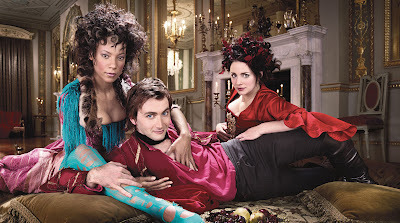 David Tennant in the title role of the BBC drama "Casanova."The model for our ideal lover is Giacomo Casanova. Perhaps the most prolific seducer in history, few women were able to resist him. And his secret? The answer was to study the object of his desire, find out what was lacking from her life and then offer it. So from bored wife to lonely spinster, Casanova took on the part of ideal lover by providing excitement for the wife, and company for the spinster. This takes time, patience, attention to detail and perhaps a denial of self-importance that not all people are capable of.
David Tennant in the title role of the BBC drama "Casanova."The model for our ideal lover is Giacomo Casanova. Perhaps the most prolific seducer in history, few women were able to resist him. And his secret? The answer was to study the object of his desire, find out what was lacking from her life and then offer it. So from bored wife to lonely spinster, Casanova took on the part of ideal lover by providing excitement for the wife, and company for the spinster. This takes time, patience, attention to detail and perhaps a denial of self-importance that not all people are capable of. 
The qualities of an ideal lover (in terms of seductive powers) are:- Being humble - adoring the object of his attention and yet seeming surprised when that attention is returned -Anticipation - being in the right place at the right time, with the right comment on the tip of his tongue.- Absorbed - to be interested in anything and everything to do with his lover- A longing to be with his lover, as reflected by his reluctant leave taking.
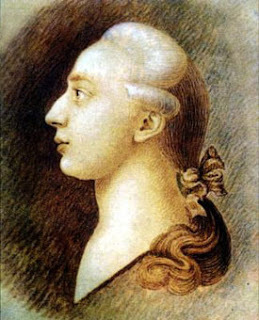 A portrait of the real Casanova.In the excerpts below, we learn of the importance of making the right sort of exit.
A portrait of the real Casanova.In the excerpts below, we learn of the importance of making the right sort of exit."The lady urges him on, 'Come my friend it's getting light. You don't want anyone to find you here.' He gives a deep sigh, as if to say that the night has not been nearly long enough and that it is agony to leave." RIGHT WAY to leave
"When he jumps out of bed, scurries about the room, tightly fastens his trouser sash, rolls up the sleeves of his court cloak…and stuffs his belongings into the breast of his robe and then briskly secures the outer sash - one really begins to hate him." WRONG WAY to leave.
The Pillow Book of Sei Shonagon.
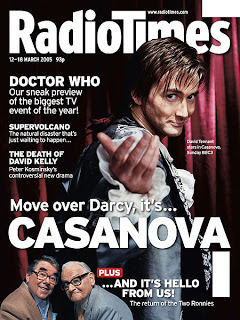
Who knows how Casanova's many conquests felt about his attentions, for just like the rake, he was besotted but never committed to one woman in the long term. He learnt how to use his personal attractiveness to get what he wanted by playing the part of 'the ideal lover'. But don't be deceived - not only was Casanova skilled at getting what he wanted, he was almost the consummate master of making excuses and then leaving….
"The cultivation of the pleasures of the sense was ever my principal aim in life. Knowing that I was personally calculated to please the fair sex, I always strove to make myself agreeable." Casanova.
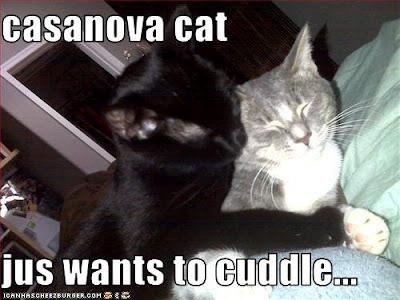 With thanks to Cheezburger.com
With thanks to Cheezburger.com
Published on February 22, 2012 02:53
February 15, 2012
The Great Seducers - The RAKE.

"The Rake burns with a desire that enflames the woman his is seducing."
In the second of this series of posts, our next class of seducer is that dangerous figure much beloved by historical romance writers, the rake. One of the reasons a rake is such a great fun to write about is that he is a master of seductive language and his unrestrained pursuit was enough to stir many a woman's suppressed longings. In the past, when women often lead deeply repressed and controlled lives, the rake offered excitement and pleasure. Marriage was a duty rather than romance, so what could have been more alluring than a man who lived only for her…if only for a short time?
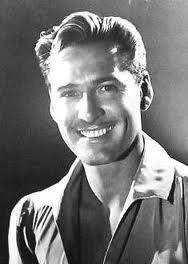 Hollywood film star, Errol Flynn, had a repuation as a rake.Rakes did not offer mild excitement, but something rare and thrilling, something worth taking a risk for. Added to that, that the resistance of his prey is only a vehicle for the rake's creativity and he becomes almost irresistible, for even his dangerous reputation adds allure as his quarry wonders if she will be the woman to tame him.
Hollywood film star, Errol Flynn, had a repuation as a rake.Rakes did not offer mild excitement, but something rare and thrilling, something worth taking a risk for. Added to that, that the resistance of his prey is only a vehicle for the rake's creativity and he becomes almost irresistible, for even his dangerous reputation adds allure as his quarry wonders if she will be the woman to tame him.
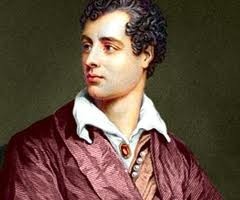 Lord Byron - another famous rake.One such rake was the notorious Fronsac, Duke de Richelieu, (his grand-uncle became Cardinal Richelieu, featured in The Three Muskateers.)As a 15 year old, he charmed the ladies at the court of an elderly Louis XIV. After overstepping the mark with a duchess, an irate King sent the young Fronsac to cool his heels in the Bastille. Years later he used his dangerous reputation as a seducer and heartbreaker to draw women to him.
Lord Byron - another famous rake.One such rake was the notorious Fronsac, Duke de Richelieu, (his grand-uncle became Cardinal Richelieu, featured in The Three Muskateers.)As a 15 year old, he charmed the ladies at the court of an elderly Louis XIV. After overstepping the mark with a duchess, an irate King sent the young Fronsac to cool his heels in the Bastille. Years later he used his dangerous reputation as a seducer and heartbreaker to draw women to him. One such woman was the young Mademoiselle de Valois, who one day was walking in a Paris park with her chaperone. De Valois' father guarded her obsessively and employed a sour, unimpeachable woman as her constant companion to deterr undesirable admirers. On the walk a young man caught her eye with one smouldering look. This man was, her guardian told her, the now infamous Duke de Richelieu. Days later, in a different park Richelieu passed de Valois again, but this time disguised as a beggar. However his smouldering intensity could not be hidden from de Valois. He represented excitement in her drab routinue, and that of all the beautiful ladies, he had chosen her to pursue added an extra piquancy to her sheltered life. Richelieu smuggled notes to her, which expressed his uncontrollable infatuation, and she responded. The Duke, eager to spend a night with de Valois, even dressed as her maid to gain entry to her bedchamber. She begged him to leave, but his personal attraction overcame her resistance, she forgot all reason and gave in. to desire.
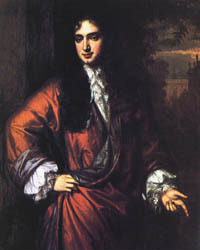 The most rakish of all - The Earl of Rochester. "If I believed in sorcery I should think that the Duke possessed some supernatural secret, for I have never known a woman to oppose the very least resistance to him." The Duchess d'Orleans ( Mademoiselle de Valois' mother.)
The most rakish of all - The Earl of Rochester. "If I believed in sorcery I should think that the Duke possessed some supernatural secret, for I have never known a woman to oppose the very least resistance to him." The Duchess d'Orleans ( Mademoiselle de Valois' mother.) When de Valois' father increased security around his daughter, Richelieu only took this as a challenge. Under an assumed name he bought the adjoining house and cut a hole through the wall into his neighbour's kitchen cupboard. The trysts between Richelieu and de Valois continued…until he grew bored with her and moved on....
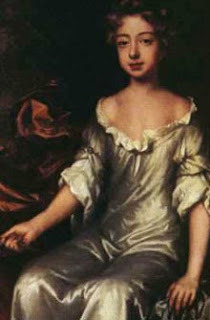 Elizabeth Mallet - one of the Earl of Rochester's many conquests.Richelieu's exploits with women were notorious and yet he even turned this to advantage. What Richelieu knew was that intense desire has a distracting effect on women. A woman is often suspicious and can sense insincerity, but when the rake is inflamed for her and will brave danger and breech any barriers to get to her, she is more inclined to overlook his other shortcomings. So long as he seemed the slave to her charms, the woman would not think of the aftermath.
Elizabeth Mallet - one of the Earl of Rochester's many conquests.Richelieu's exploits with women were notorious and yet he even turned this to advantage. What Richelieu knew was that intense desire has a distracting effect on women. A woman is often suspicious and can sense insincerity, but when the rake is inflamed for her and will brave danger and breech any barriers to get to her, she is more inclined to overlook his other shortcomings. So long as he seemed the slave to her charms, the woman would not think of the aftermath. "What a man! What a man! He is astonishing! How often you could be happy with him if he were only faithful." Madame Renaud.
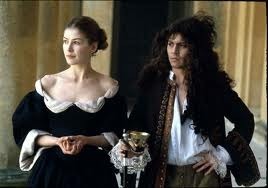 Johnny Depp as notorious rake, Lord Rochester, in the filim, The Libertine.So, if you were going to caste a movie featuring a rake, who would make the perfect leading man?
Johnny Depp as notorious rake, Lord Rochester, in the filim, The Libertine.So, if you were going to caste a movie featuring a rake, who would make the perfect leading man? Do leave a comment and share your thoughts!
NEXT WEEK: The Ideal Lover.
CONGRATULATIONS TO DARLENE! (Winner of last week's blog hop giveaway.)
Published on February 15, 2012 10:32
'Familiar Felines.'
Following on from last weeks Halloween posting, today's blog post looks at the unwanted image of cats as the witches familiar - from the Norse Goddess Freya to lonely women in the middle ages.
The full Following on from last weeks Halloween posting, today's blog post looks at the unwanted image of cats as the witches familiar - from the Norse Goddess Freya to lonely women in the middle ages.
The full post can found at:
http://graceelliot-author.blogspot.com
...more
The full Following on from last weeks Halloween posting, today's blog post looks at the unwanted image of cats as the witches familiar - from the Norse Goddess Freya to lonely women in the middle ages.
The full post can found at:
http://graceelliot-author.blogspot.com
...more
- Grace Elliot's profile
- 156 followers



